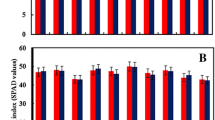Abstract
Cellular thermotolerance in terms of cellular membrane thermostability is often implied as an indication of crop heat tolerance and it is therefore considered as a possible selection criterion for heat tolerance. While there is ample genetic variability for cellular thermotolerance in wheat and other crop plants its relations to yield under heat stress is not sufficiently established. This study was performed to assess the genetic relations in wheat between cellular thermotolerance and yield under heat stress. In one study the co-segregation among cellular membrane thermostability (CMS), yield under chronic heat stress and yield under non-stress conditions was evaluated in a random inbred line (RIL) population of a cross between heat resistant (Danbata) and heat susceptible (Nacozari) cultivars. In a second study the same association was evaluated for yield under heat stress in 49 F7 breeding lines randomly selected from a breeding program. CMS was assayed in growth chamber grown and heat-hardened seedlings. Yield was evaluated under Mediterranean summer irrigated conditions where chronic heat stress caused a reduction in mean yield of the RIL population by 47% as compared with the normal winter growing conditions (non-stress). The RILs varied significantly (p<0.05) for CMS, biomass and yield under stress and non-stress conditions. The two parent cultivars did not differ in biomass or yield under non-stress (winter) conditions but they widely differed for both traits under heat stress. Yield of RILs under heat stress was well distributed between the extreme values of the parent cultivars. There was a significant RIL by season interaction for biomass (F = 9.74; p<0.0001) and yield (F = 10.08; p<0.0001), indicating specific adaptation to heat stress of certain lines in terms of their productivity. Broad-sense heritability for yield was high and nearly the same in the winter (h 2=0.71)and the summer (h 2=0.67). Broad-sense heritability for CMS was high (h 2=0.74). CMS was positively and significantly (p<0.01) correlated across 98 RILs with biomass (r = 0.60* *) and yield (r = 0.53**) under stress but rot with biomass or yield under non-stress conditions. The 49 breeding lines varied significantly (p<0.01) for CMS and yield under chronic heat stress in the summer season. CMS and yield were significantly correlated (r = 0.56**) across lines. Overall the associations between CMS and yield under heat stress were reasonably strong and significant but not perfect. Other factors besides cellular thermostability may support yield under heat stress. CMS alone cannot be used as the exclusive selection criterion for heat tolerance in wheat breeding. lt may be valuable as a supplemental criterion in the final breeding stages or as a rough selection tool to reduce a large population into the most likely heat tolerant core at the early stages of the breeding program.
Similar content being viewed by others
References
Blum, A., 1988. Plant Breeding for Stress Environments, p. 223. CRC Press, Boca Raton.
Blum, A., G. Golan, J. Mayer, B. Sinmena & J. Burra, 1989. The drought response of landraces of wheat from the Northern Negev desert in Israel. Euphytica 43: 87–96.
Blum, A. & A. Ebercon, 1981. Cell membrane stability as a measure of drought and heat tolerance in wheat. Crop Sci 21: 43–47.
Ceccarelli, S., 1989. Wide adaptation: How wide? Euphytica 40: 197–205.
Ceccarelli, S., S. Grando & A. Impiglia, 1998. Choice of selection strategy in breeding barley for stress environments. Euphytica 10: 307–318.
Fokar, M., A. Blum & H.T. Nguyen, 1998. Heat tolerance in spring wheat. II. Gram filling. Euphytica 104: 9–15.
Hall, A.E., 1992. Breeding for heat tolerance. Plant Breeding Rev 10: 129–167.
Lu, Z.M., J.W. Radin, E.L. Turcotte, R. Percy & E. Zeiger, 1994. High yields in advanced lines of pima cotton are associated with higher stomatal conductance, reduced leaf area and lower leaf temperature. Physiol Plant 92: 266–272.
Reynolds, M.P., M. Balota, M.I.B. Delgado, I. Amani & R.A. Fischer, 1994. Physiological and morphological traits associated with spring wheat yield under hot, irrigated conditions. Aust J Plant Physiol 21: 717–730.
Shanahan, J.F., I.B. Edwards, J.S. Quick & J.R. Fenwick, 1990. Membrane thermostability and heat tolerance of spring wheat. Crop Sci 30: 247–251.
Shpiler, L. & A. Blum, 1991. Heat tolerance for yield and its components in different wheat cultivars. Euphytica 51: 257–263.
Author information
Authors and Affiliations
Rights and permissions
About this article
Cite this article
Blum, A., Klueva, N. & Nguyen, H. Wheat cellular thermotolerance is related to yield under heat stress. Euphytica 117, 117–123 (2001). https://doi.org/10.1023/A:1004083305905
Published:
Issue Date:
DOI: https://doi.org/10.1023/A:1004083305905




